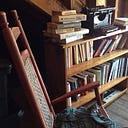From The Attic — for a Kinder, Cooler America
CHICAGO, FEBRUARY 1916 — On a frigid and windblown day, a small item appeared in a Chicago newspaper. Several hundred black families had quietly left Selma, Alabama, heading north. Their treatment in the South, one refugee told the paper, “doesn’t warrant staying.”
The 1910s marked the peak of American newspapers. More than a thousand nationwide, several in each major city, printed news in black and white. Yet no other newspaper tracked this all-black story, just the Chicago Defender.
Black newspapers had come and gone, none attracting more than a thousand readers. But the Defender, born in the darkest days of Jim Crow, became a voice of freedom, of justice, of hope. The flagship of the black press, the Defender was as proud and determined its founder.
Raised in a mixed-race family, with a German step-father and black mother, Robert Sengstacke Abbott hated the words “Negro” and “black.” During his 35 years at the helm of the Defender, the newspaper never used either. African-Americans were simply “the Race.”
Abbott came by his pride the usual way — through insult. After studying printing at the Hampton Institute, he earned a law degree in Chicago. But practicing law in Gary, Indiana and Topeka, Kansas, he met bigotry face-to-face. Who in the age of Plessy v. Ferguson, of “separate but equal,” would hire a black lawyer?
Outraged, Abbott returned to Chicago. Then in 1905, he saw that the growing Chicago neighborhood locals called “Bronzeville” needed its own newspaper. Nothing blacks did, other than crime, ever made the conservative Chicago Tribune. Why not a separate but equal paper to cover “the Race?”
Abbott printed the first edition in the kitchen of his boarding house. He distributed 300 copies door-to-door. He sold ads. He set type. He wrote and wrote. And circulation grew. In 1910, he hired his first editor, a man schooled in the tabloid tactics of the Hearst Press. With full page photo spreads and bold headlines, many printed in red, the Defender claimed its place in Chicago. The Trib called itself “The World’s Greatest Newspaper.” Not to be outdone, Abbott called the Defender “The World’s Greatest Weekly.”
Circulation rose, by 1916, to 50,000. That year, the migration began, thousands, then tens of thousands of African-Americans began fleeing the South, seeking “the warmth of other suns.” The Defender would be their cheerleader and guiding light.
On May 15, 1917, Abbott proclaimed a “Great Migration Day.” Calling for an epic “Flight out of Egypt,” the Defender offered a discount — three bucks for a train ticket to Chicago. When some 2,000 blacks a day began arriving, The Trib headlined “HALF A MILLION DARKIES FROM DIXIE SWARM TO THE NORTH. . .” But the Defender met the arrivals at the train station with banners reading “SAVED FROM THE SOUTH.”
Once blacks began streaming into Detroit, New York, Philadelphia, smaller black newspapers flourished. The Pittsburgh Courier. The St. Louis Argus. Too many in Harlem to name. But the Defender remained the black newspaper of record.
As circulation approached 200,000, only a third of Defender readers lived in Chicago. Abbott had arranged for black Pullman porters working on southbound trains to spread the paper and its promise. The Defender listed Chicago jobs, housing, train schedules, and touted the open atmosphere of the North. When some Southern states banned the Defender, porters smuggled it, dumping bundles of papers at secret locations where they were picked up and passed out to be read aloud in homes, churches, and barber shops.
And more came north. And more.
Along with daily news, the Defender had a list of causes, the Defender’s Bible. Demands included anti-lynching laws, the hiring of black bus drivers, railroad engineers, and conductors, full voting rights, and the destruction of all “American race prejudice.”
Readers relished the Defender’s commitment, but they also turned to it for news more black than white. When race riots scarred Chicago in 1919, the Trib denounced “a crowd of howling Negroes” and printed a casualty list that was 3/4 white. The Defender, however, saw the savage truth historians later confirmed: a black teenager’s innocent drift onto a Whites Only beach had unleashed white mobs — “a certain madness distinctly indicated in reports of shootings, stabbings and burning of buildings. . . ” Two-thirds of the casualties, the Defender noted, were black.
Abbott died in 1940, leaving the paper to his nephew. John H. Sengstacke made the Defender a daily in 1955, offering full coverage of the Emmett Till lynching, the rise of Martin Luther King, and marches across the South. Noted writers, including Langston Hughes, Richard Wright, and Gwendolyn Brooks wrote for the Chicago Defender.
As some of its Bible became law, the Defender lost readers. Black reporters began working for major papers, even the Trib. Circulation dropped as TV news surged. The Defender pressed on into the new century, becoming a weekly again in 2008, then closing its print edition in 2019. But you can still read the flagship of the black press online.
The Chicago Defender, Langston Hughes wrote, was “the journalistic voice of a largely voiceless people.” But although Hughes was the great American dream poet, the news offered a nearer dreamworld. “If all of their dream does not come true,” the Defender wrote of the Great Migration, “enough will come to pass to justify their actions.”
